
Product Ideation Process: Stages, Methods and Tools
In today's fast-paced digital landscape, understanding the intricacies of product ideation is crucial for businesses seeking to create tools that effectively capture and analyze customer feedback. This process is not just about generating new product ideas; it's about innovating and refining solutions that resonate deeply with the needs and expectations of users.
Let's delve into the various stages of the product ideation process, from the initial research and understanding of your target market to the generation and screening of ideas and finally to concept development and testing.
Each stage is critical in ensuring that your product meets and exceeds market demands. Whether you're a startup looking to break into the market or an established company aiming to upgrade your existing tools, this guide will provide valuable insights into creating products that align with your customers' voices.
What is Product Ideation?
Product ideation is a customer-centric process of generating, developing, and communicating new product ideas. It's a crucial phase in product development and involves brainstorming, conceptualizing, and exploring various possibilities for creating or improving new products.
Product ideation is a foundational stage in the product development lifecycle, setting the direction for what will eventually become a marketable product. It's about balancing creativity with practicality and ensuring new product ideas align with user needs and business objectives.
Benefits of Product Ideation
- Encourages Innovation: Ideation fosters creativity, leading to innovative and potentially groundbreaking product ideas that can offer new solutions and improvements.
- Aligns with Market Needs: Through research and customer involvement, ideation ensures that products are closely aligned with market demands and customer expectations, enhancing their likelihood of success.
- Reduces Risks and Costs: Early evaluation of feasibility and viability ideas helps mitigate risks and reduce the costs of developing unviable products.
- Boosts Competitive Advantage: Continuous generating fresh ideas keeps a company adaptable and ahead in the market, strengthening its brand and competitive position.
Stages of Product Ideation Process
The product ideation process involves a series of steps aimed at creating new product ideas or improving existing ones.
1. Preparation and Research
This initial stage is about laying the groundwork. It involves conducting thorough research to understand the market, identify customer needs and pain points, and analyze competitors. This research provides the necessary context and insights to guide the ideation process, ensuring that the ideas generated are relevant and targeted.
2. Idea Generation
In this creative phase, the focus is on generating a wide range of ideas without immediate judgment or evaluation. Techniques like brainstorming, mind mapping, and SCAMPER are often used. The goal is to encourage out-of-the-box thinking and generate diverse ideas, which could lead to innovative solutions.
By leveraging feedback management software, companies can streamline the feedback collection process to gather real-time ideas and feedback, ensuring timely responses and reducing the risk of missing critical user insights.

3. Idea Screening and Evaluation
After generating many ideas, the next step is to screen and evaluate them. This involves assessing each idea for feasibility, potential market success, and alignment with business objectives. Ideas that don't meet the set criteria are filtered out, leaving a more refined set of viable concepts to consider.
Set up an internal team feedback system for screening and evaluating ideas collected from customer-facing teams and shared with the product team.
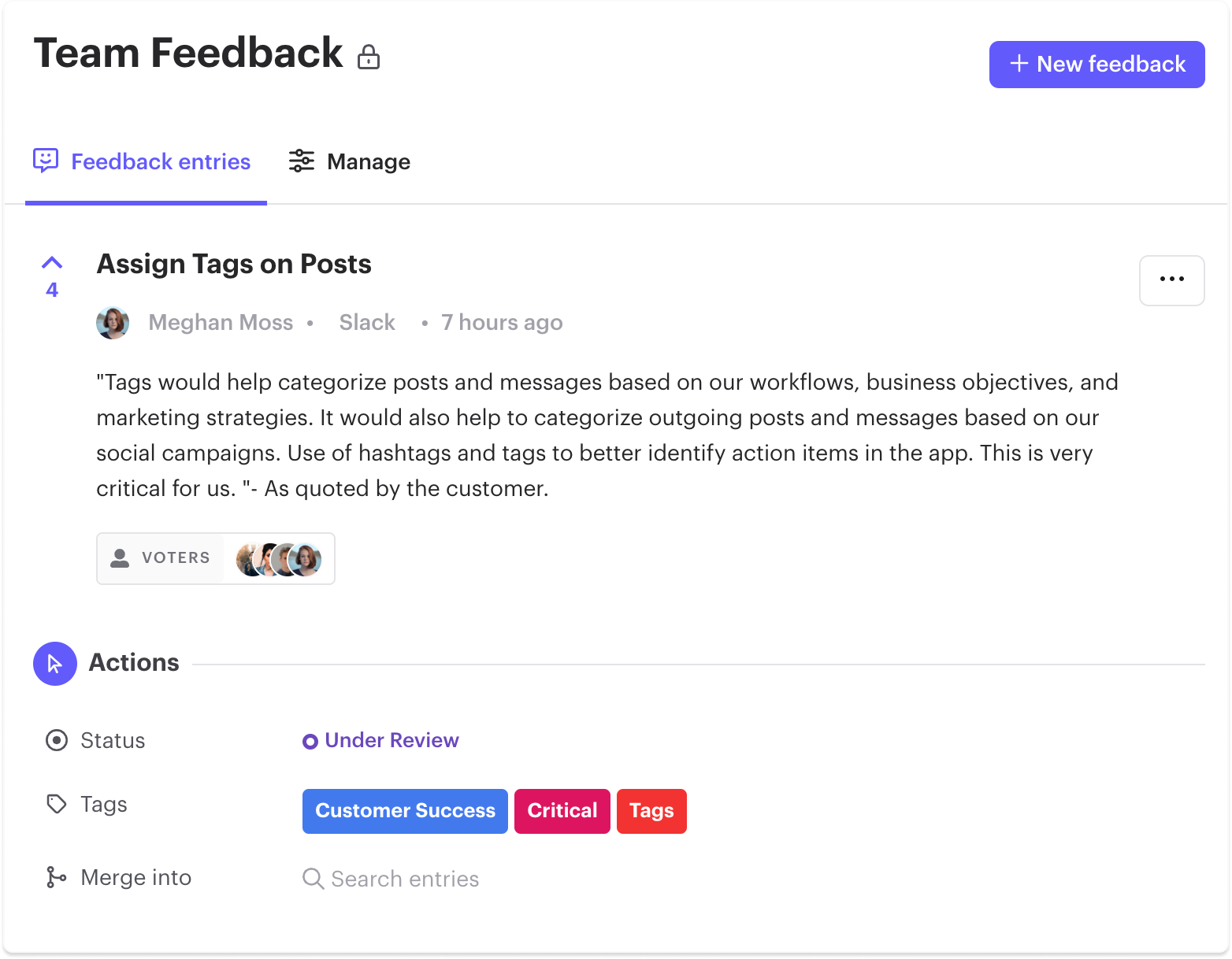
4. Concept Development
In this stage, the selected ideas are developed into more detailed concepts. This may include creating prototypes, developing storyboards, or drafting more detailed plans. The aim is to explore each idea's potential in greater depth and understand how it might be realized as a viable product.
Evaluate the potential success of a new product concept before it's fully developed. Present the product idea (through mockups, descriptions, or prototypes) to a target audience and gather feedback with feedback tools such as Rapidr etc.
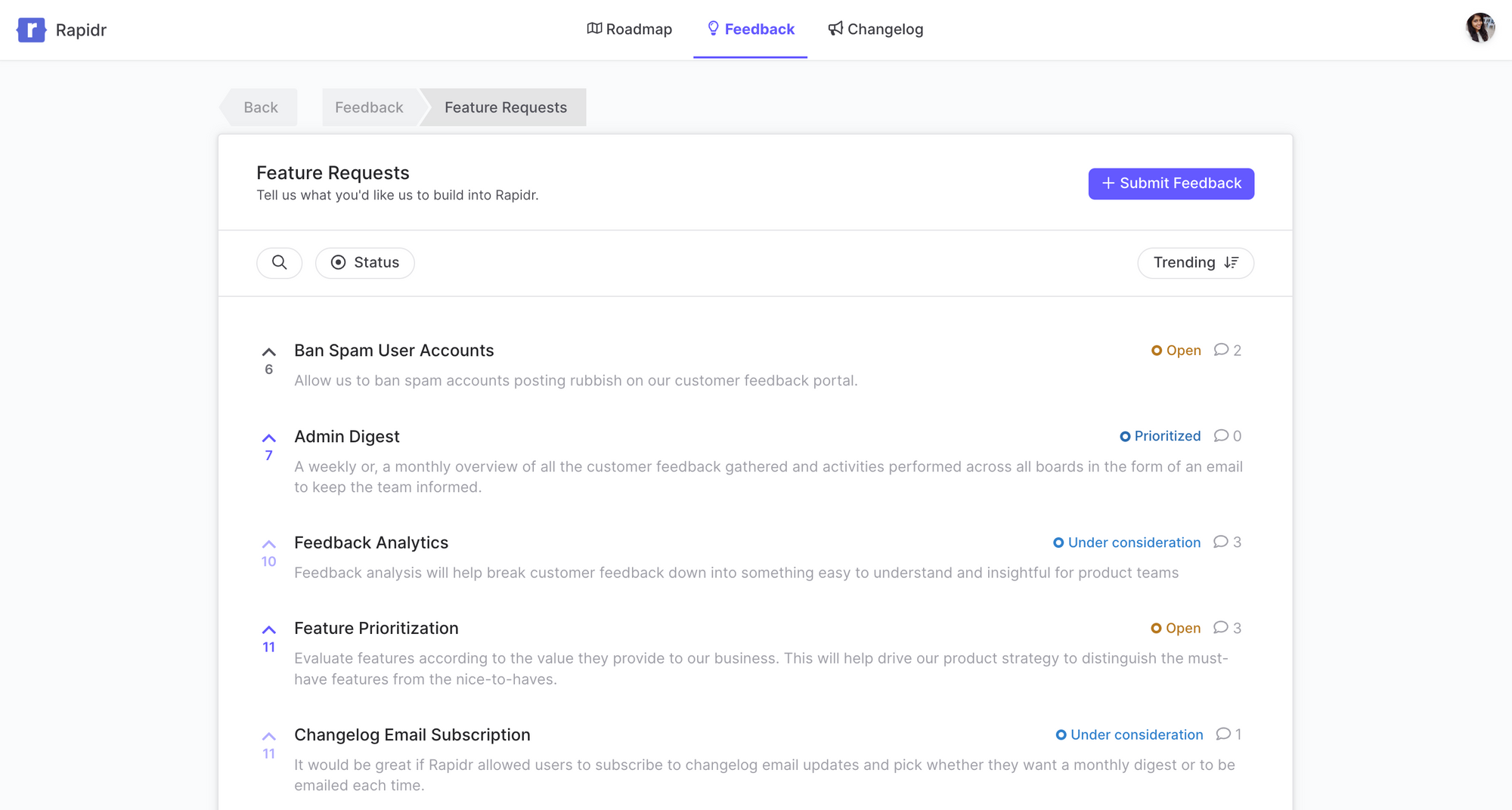
Rapidr provides an idea management system solely for this purpose. Use votes and comments within an idea voting board to prioritize features. Evaluate, sort, and filter ideas based on how well they map to the market, customers' needs, and your company's strengths.
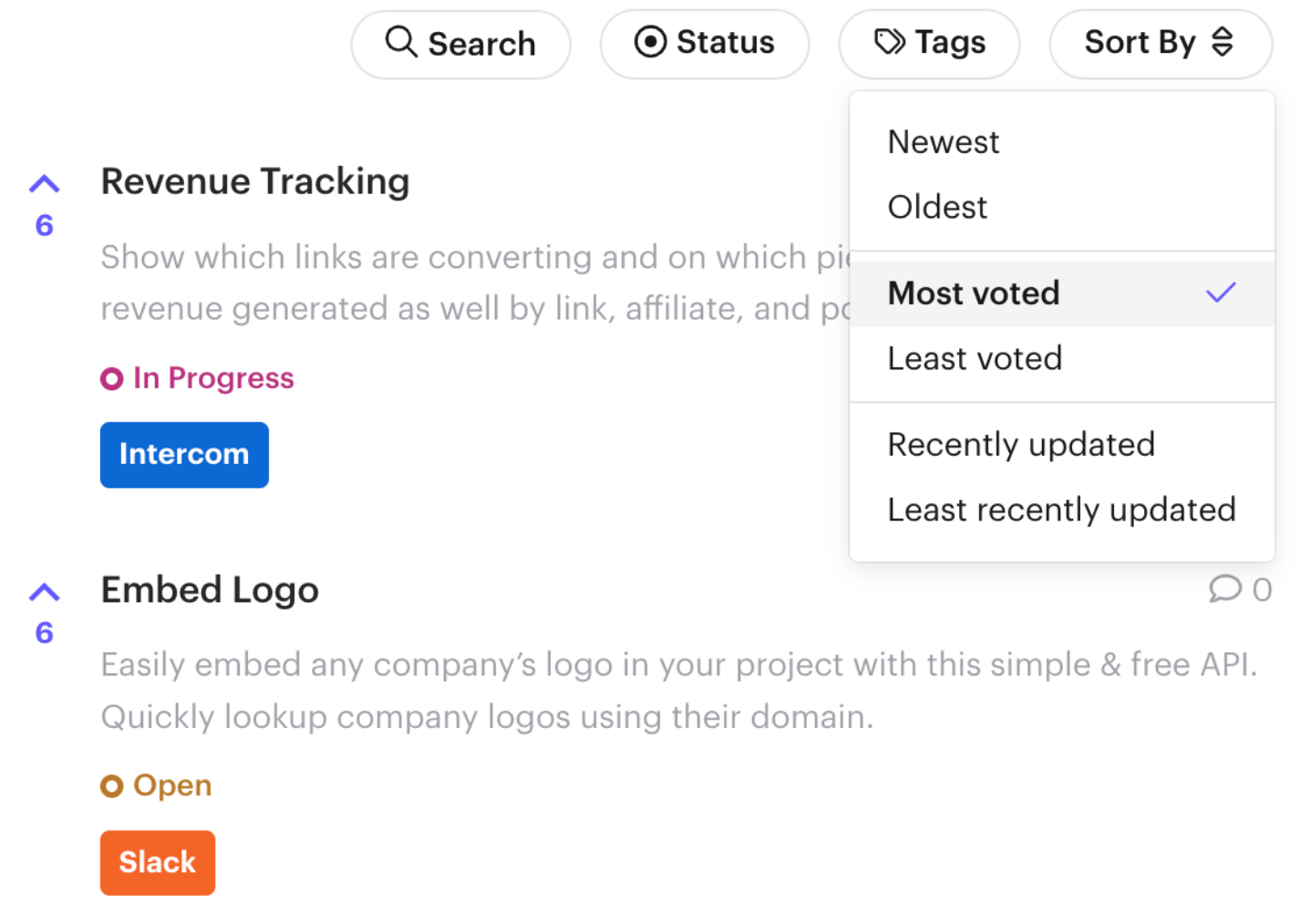
5. Prototype and Testing
Prototypes or mock-ups of the top ideas are created and tested. This beta testing can be done internally or with a select group of users. The feedback received is crucial for understanding the strengths and weaknesses of each concept, leading to further refinements.
6. Final Selection and Implementation
The best ideas are selected for implementation based on the testing and feedback. This stage involves detailed planning for product development, including timelines, resource allocation, and setting up production processes.
The selected idea(s) move into the product development phase, where they are developed into full-fledged products. Utilize in-app feedback platforms to ask users about their experiences in real time. This can be done through chatbots or pop-up messages, prompting immediate feedback while the user is engaged with the product.
It's impossible to say yes to all ideas, but the right ones can help guide your product roadmap. Share your findings with team members, executives, and other stakeholders to drive decision-making. When you release new features or updates, reach out to users to see how they find them. Clear communication is vital to cohesive development, even if it means responding to negative feedback.

Product Ideation Methods and Techniques
Product ideation methods and techniques are diverse and can be tailored to suit different industries, company cultures, and product types. These methods stimulate creativity, encourage out-of-the-box thinking, and generate a broad range of ideas.
Here's an overview of some effective ideation methods and techniques:
Brainstorming and Brainwriting
Brainstorming is a classic method where team members generate ideas in a group setting. The emphasis is on quantity over quality, encouraging free-flowing and uninhibited thought. This technique thrives on the synergy of the group, where ideas from one person can spark further ideas from others.
User Feedback Collection
The user feedback collection technique in product ideation involves gathering insights, opinions, and experiences from current or potential users about a product or service. This approach is centered on understanding the user's needs, preferences, pain points, and overall experience.
Surveys, interviews, focus groups, or user testing sessions are commonly employed. Collecting user feedback provides valuable, real-world insights to guide the ideation process, ensuring that new product ideas or improvements align with users' wants and needs.
This technique is crucial for creating user-centric products and can significantly enhance the relevance and potential success of the resulting innovations. Create a centralized place for product feedback to keep track of different types of customer feedback and improve SaaS products while listening to their customers. This is possible with Rapidr.
Rapidr helps companies be more customer-centric by consolidating feedback across different apps, prioritizing requests, having a discourse with customers, and closing the feedback loop.
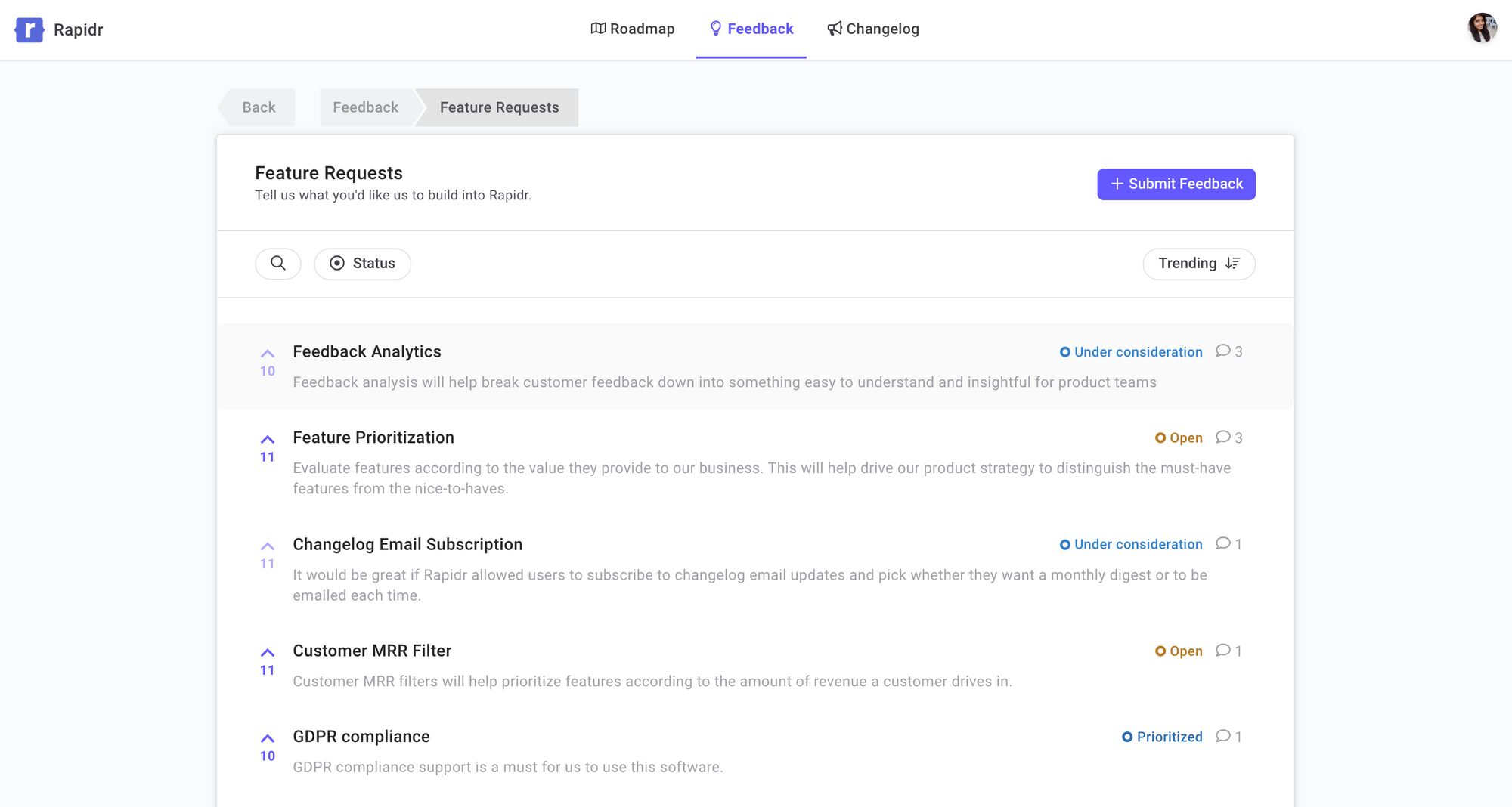
"How Might We" Statements
The "How Might We" (HMW) technique in product ideation is a method for transforming challenges into opportunities for creative problem-solving.
It involves reframing problems identified through research or brainstorming into open-ended HMW statements, such as turning "Customers are unhappy with the slow response time" into "How might we improve our response time to enhance customer satisfaction?"
This approach encourages a broad range of innovative solutions by keeping the questions intentionally open-ended and positive. It's particularly effective in collaborative settings, as it leverages diverse perspectives and fosters a solution-oriented mindset, shifting the focus from limitations to possibilities and opportunities for improvement.
Mind Mapping
Mind mapping is a visual technique where a central idea is placed at the center of a diagram, and related ideas are branched out from it. Starts with a central idea and branches into associated concepts, allowing for visually exploring relationships and themes. This method helps organize thoughts and explore the relationships between different concepts, making it easier to identify potential areas for innovation.
Focus Groups and User Interviews
Engaging with potential users or customers through interviews or focus groups can yield valuable insights. These methods help understand user needs, experiences, and feedback, which are crucial for tailoring products to market demands.
SCAMPER
SCAMPER stands for Substitute, Combine, Adapt, Modify, Put to another use, Eliminate, and Reverse. It's a checklist approach that prompts users to think about ways to innovate on an existing product or idea. This method is beneficial for improving or adding new product features.
Storyboarding
Storyboarding in product ideation is a visual and narrative technique to explore and communicate the user's journey with a product or service. It involves creating a series of panels or illustrations that depict how users would interact with a potential product, from initial engagement to various usage scenarios and outcomes.
This method helps visualize and understand the user experience and identify potential challenges and opportunities within different stages of interaction. Storyboarding is particularly effective for discussing and refining ideas in a collaborative setting, providing a clear and engaging way of presenting concepts.
By mapping out the user's journey, storyboarding ensures that the product development is focused on creating a user-friendly and meaningful experience.
Improve their Product Ideation Process with Rapidr
The ideation process is more than just a procedure; it's an art form that balances creativity with practicality and dreams with reality. It's about turning fleeting thoughts into tangible products that can change the market landscape.
As we've seen, the key to successful product ideation lies in a deep understanding of the target audience, a culture that fosters creativity and collaboration, and an unwavering commitment to refining and improving ideas.
Rapidr's intuitive idea and innovation management solution helps manage the entire idea management process, from capturing ideas to prioritizing them, informing product roadmap, and sharing updates with changelog.
Rapidr allows you to capture and track all ideas via feedback widgets and organize and analyze them in a centralized location. Then, inform your roadmap with the most impactful feedback and notify users of what's new with release notes and closing the feedback loop.
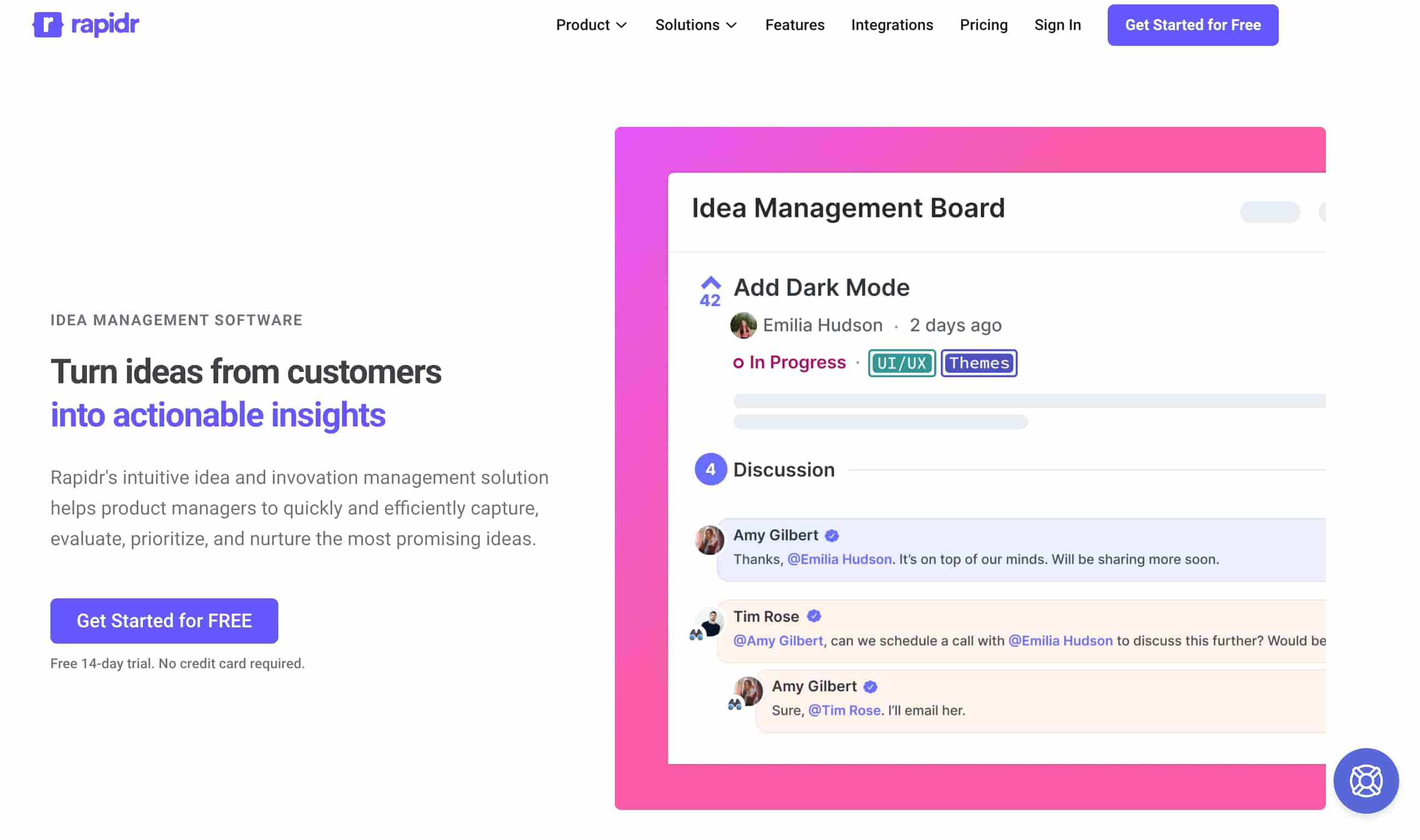
Key Features For Product Ideation
- Rapidr is an end-to-end idea management solution, so you don't have to glue multiple apps together. You get idea submission, ideation brainstorming, road mapping, and release notes software.
- Rapidr is one of the most affordable and cost-effective solutions offering excellent value.
- Rapidr's hosted idea boards portal and in-app feedback widgets are lightweight, easy to use, and customizable, fitting perfectly with your existing workflows and brand design.
- Rapidr helps you gather ideas via a feedback portal, feedback widgets, and many integrations with tools you already use, like Zapier, Intercom, and Slack.
Whether you're a seasoned product developer or a budding entrepreneur, remember that great products start with great ideas. Great ideas are born from processes that encourage exploration, challenge norms, and embrace the potential of 'what could be.' Sign up to build better products with the power of customer feedback today.

